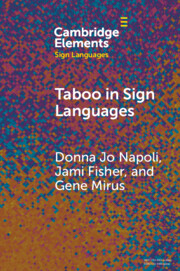Element contents
Taboo in Sign Languages
Published online by Cambridge University Press: 05 October 2023
Summary
- Type
- Element
- Information
- Series: Elements in Sign LanguagesOnline ISBN: 9781009291972Publisher: Cambridge University PressPrint publication: 26 October 2023
References
- 1
- Cited by



